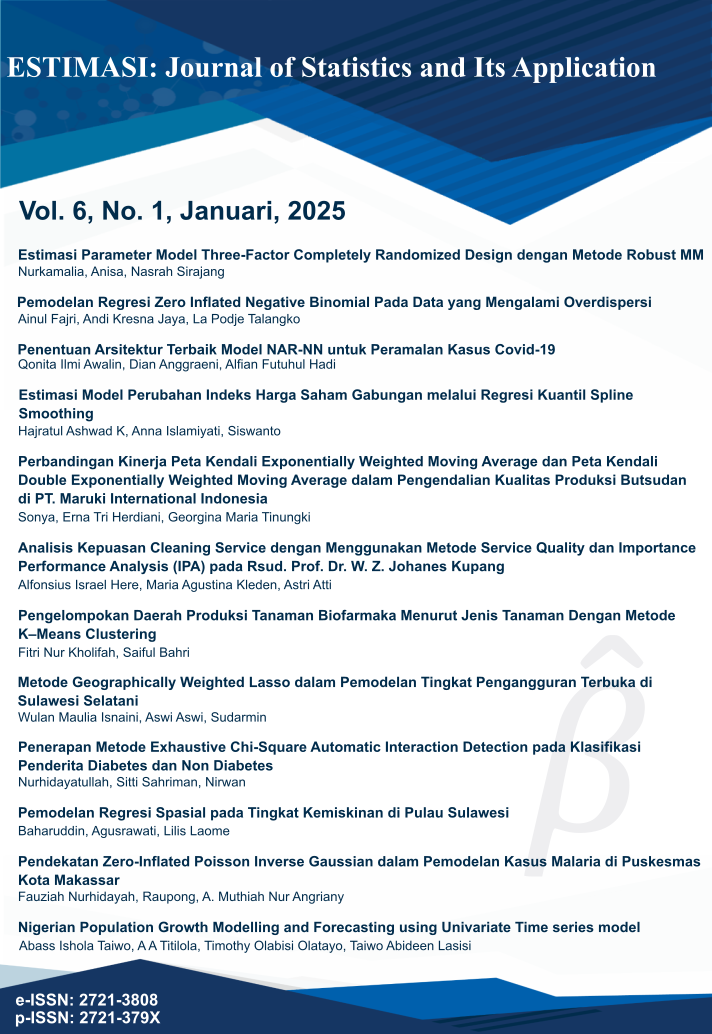Pengelompokan Daerah Produksi Tanaman Biofarmaka Menurut Jenis Tanaman dengan Metode K – Means Clustering
DOI:
https://doi.org/10.20956/ejsa.v6i1.27200Keywords:
Biopharmaceuticals, BPS, Clustering, C1, C2, K-MeansAbstract
Biopharmaceutical plants or commonly called medicinal plants are plants in which one, several or all parts of these plants contain substances or active ingredients that are useful for body health, disease healing or cosmetic ingredients. Based on data from the Central Bureau of Statistics (BPS), the production of biopharmaceutical plants varies in each region. So that in an effort to equalize the results of biopharmaceutical production in Indonesia, it is necessary to group areas that have the potential to produce biopharmaceutical plants to find out which areas produce in large or small quantities. In this research, a method is needed to facilitate the grouping of biopharmaceutical producing regions, one of which is the clustering analysis method. . One of the methods that can be used in cluster analysis is the k-means clustering algorithm. The results of this study indicate that there are 5 provinces that are included in cluster 1 (C1) with the category of low biopharmaceutical production in 2021. Meanwhile, 29 other provinces are included in the cluster. 2 (C2) with the category of high biopharmaceutical production areas in 2021.
References
Ariyanto, S. E., & Indaryani, M. Potensi Tanaman Obat (Biofarmaka) di Kabupaten Jepara. Semin. Nas., 2017, pp. 277–285, 2022.
Listyana, N. H., Darsono, D., & Sutrisno, J. Potensi Pengembangan Tanaman Obat Di Wilayah Aglomerasi Solo Raya. J. Tumbuh. Obat Indones., 15(1), pp. 27–30, 2022, doi: 10.22435/jtoi.v15i1.5846.
Parawansah, A. E., & Saida. Sosialisasi Pemanfaatan Tanaman Obat Keluarga Sebagai Upaya Untuk Meningkatkan Imunitas Tubuh Ditengah Pandemi di Kota Kendari. J. Community Engagem. Heal., 3(2), pp. 325–328, 2020.
Silalahi, C. J., Situmorang, A., & Naibaho, J. F. Implementasi Metode K-Means Clustering Untuk Memetakan Daerah Potensial Penghasil Padi di Provinsi Sumatera Utara. Methotika J. Ilm. Tek. Inform., 2(2), pp. 49–57, 2022, [Online]. Available: http://ojs.fikom-methodist.net/index.php/methotika
Herviany, M., Delima, S. P., & Nurhidayah, T. Comparison of K-Means and K-Medoids Algorithms for Grouping Landslide Prone Areas in West Java Province. MALCOM Indones. J. Mach. Learn. Comput. Sci. J., 1(4), pp. 34–40, 2021.
Nasari, F. Pengelompokkan Daerah Produksi Kelapa Sawit Menggunakan Algoritma K-Means Clustering. J. Sains dan Ilmu Terap., 4(2), pp. 34–38, 2021.
Syaifuddin, S., Ramlah, R., Hakim, I., Berliana, Y., & Nurhayati, N. Pemetaan Produksi Tanaman Tomat di Indonesia Berdasarkan Provinsi Menggunakan Algoritma K-Means Clustering. J. Comput. Syst. Informatics, 3(4), pp. 222–228, 2022, doi: 10.47065/josyc.v3i4.2206.
Batubara, D. N., Windarto, A. P., Hartama, D., & Satria, H. Analisis Metode K-MEANS Pada Pengelompokan Keberadaan Area Resapan Air Menurut Provinsi. Semin. Nas. Sains Teknol. Inf., pp. 345–349, 2019, [Online]. Available: https://prosiding.seminar-id.com/index.php/sensasi/article/view/324 (05 Juni 2020)
Alkhairi P., & Windarto, A. P. Penerapan K-Means Cluster pada Daerah Potensi Pertanian Karet Produktif di Sumatera Utara. Semin. Nas. Teknol. Komput. Sains, pp. 762–767, 2019.
Khomsatun, Ikhsan, D., Ali, M., & Kusrini. Sistem Pengambilan Keputusan Pemilihan Lahan Tanam di Kabupaten Wonosobo dengan K-Means Clustering dan Topsis. J. Nas. Pendidik. Tek. Inform. JANAPATI, 9(1), pp. 55–63, 2020.
Aditya, A., Jovian, I., & Sari, B. N. Implementasi K-Means Clustering Ujian Nasional Sekolah Menengah Pertama di Indonesia Tahun 2018 / 2019. J. MEDIA Inform. BUDIDARMA, 4(1), pp. 51–58, 2020, doi: 10.30865/mib.v4i1.1784.
Pakpahan, H. S., Widians, J. A., & Firmanda, H. D. A. Implementasi Metode K-Means Untuk Pengelompokan Potensi Produksi Komoditas Perkebunan. Adopsi Teknol. dan Sist. Inf., 1(1), pp. 52–60, 2022, doi: 10.30872/atasi.v1i1.49.
Purnaansyah, Haviluddin, Fanany, O. G. A., & Tahyudin, I. Comparison Between K-Means and Fuzzy C-Means Clustering in Network Traffic. Netw. Traffic Act, 2, pp. 301–310, 2018, doi: 10.1007/978-3-319-59280-0.
Akbar, F., Dekapriyo, E. L., Moefad, A. M., & Haris, A. M. Grouping of the Second Wave of Covid-19 Infection Areas in East Java Province Using K-Means Clustering, J. Mat. MANTIK, 8(1), pp. 53–62, 2022.
Adhe, D., Rachman, C., Goejantoro, R., & Tisna, D. Implementation ff Text Mining For Grouping Thesis Documents Using K-Means Clustering. J. EKSPONENSIAL, 11(2), pp. 167–174, 2020.
Abdurrahman, D. D., Agus, F., & Putra, G. M. Implementasi Algoritma Partitioning Around Medoids ( PAM ) untuk Mengelompokkan Hasil Produksi Komoditi Perkebunan ( Studi Kasus : Dinas Perkebunan Provinsi Kalimantan Timur ). J. Ilm. Ilmu Komput., 16(2), pp. 130–138, 2021, doi: http://dx.doi.org/10.30872/jim.v16i2.6520.
Downloads
Published
Issue
Section
License
Copyright
It is the author's responsibility to ensure that his or her submitted work does not infringe any existing copyright. Authors should obtain permission to reproduce or adapt copyrighted material and provide evidence of approval upon submitting the final version of a manuscript.


